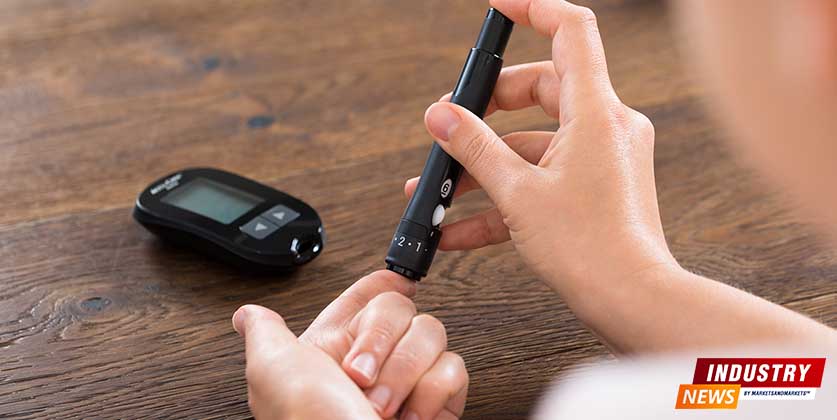Correlation between Generative AI and Diabetes - 2023's Revelations for Diabetics

This News Covers
- Diabetes Industry Generative AI Innovations in 2023
- Examples of generative AI based new tools and technologies for diabetes management
- BeatO Diabetes Care Program: A Comprehensive Analysis
- Challenges in Diabetes Management in India
- Why is diabetes exploding and is it a worrying trend worldover?
- Top industries influenced by rise in Diabetes
- Curated: Diabetes Industry Insights from MarketsandMarkets
In the past 3 months, including the current month of September, have been very interesting from perspective of healthcare domain professionals.
MarketsandMarkets welcomes these developments and we look at the details here on how each month has shaped up.
Diabetes Industry Generative AI Innovations in 2023
-
July 2023:
- Researchers at the University of California, San Francisco developed a new generative AI model that can generate realistic images of pancreatic islets, which are clusters of cells in the pancreas that produce insulin. The model was trained on a dataset of over 100,000 images of pancreatic islets from human and animal donors. The researchers believe that their model could be used to develop new drugs and treatments for diabetes, as well as to better understand the disease itself.
-
August 2023:
- A team of scientists at the Massachusetts Institute of Technology developed a new generative AI model that can generate realistic images of beta cells, which are the cells in the pancreas that produce insulin. The model was trained on a dataset of over 1 million images of beta cells from human and animal donors. The researchers believe that their model could be used to develop new ways to diagnose and treat diabetes.
-
September 2023:
- A company called DeepMind developed a new generative AI model that can generate realistic images of diabetic retinopathy, which is a complication of diabetes that can lead to blindness. The model was trained on a dataset of over 100,000 images of diabetic retinopathy from patients with diabetes. DeepMind believes that their model could be used to develop new ways to diagnose and treat diabetic retinopathy.
In addition to these specific developments, there is a growing trend of using generative AI to develop new tools and technologies for diabetes management. For example, some companies are developing generative AI models that can be used to generate personalized meal plans or exercise routines for people with diabetes. Others are developing generative AI models that can be used to create virtual diabetes coaches that can provide support and guidance to people with diabetes.
Overall, generative AI is a rapidly developing field with the potential to revolutionize the way we diagnose, treat, and manage diabetes.
Examples of generative AI based new tools and technologies for diabetes management
-
Personalized meal plans and exercise routines
- Generative AI models can be used to generate personalized meal plans and exercise routines for people with diabetes, taking into account their individual needs and preferences. This can help people with diabetes to better manage their blood sugar levels and reduce their risk of complications.
-
Virtual diabetes coaches
- Generative AI models can be used to create virtual diabetes coaches that can provide support and guidance to people with diabetes. These virtual coaches can answer questions, provide feedback, and help people with diabetes to stay on track with their treatment plans.
-
New drugs and treatments
- Generative AI models can be used to develop new drugs and treatments for diabetes. For example, generative AI models can be used to design new drugs that are more effective and have fewer side effects. Generative AI models can also be used to identify new drug targets that could be used to develop new treatments for diabetes.
Top industries influenced by rise in Diabetes
The rise in diabetes has far-reaching implications across various industries. Here's a breakdown of the industries impacted and how the rise of AI might influence these sectors:
-
Healthcare and Pharmaceuticals
- Impact: The most directly affected, this industry sees increased demand for diabetes-related medications, insulin, monitoring devices, and treatment facilities. There's also a surge in research for diabetes management and cure.
- AI's Role: AI can assist in drug discovery, personalized treatment plans, and predictive analytics to identify at-risk individuals. AI-powered devices can help patients monitor their glucose levels in real-time and predict spikes or drops.
-
Food and Beverage
- Impact: There's a growing demand for diabetic-friendly, low-sugar, and low-carb products. Companies are reformulating products to cater to this demographic.
- AI's Role: AI can analyze consumer preferences and trends, helping companies develop products that cater to diabetic needs. It can also optimize supply chains for these new products.
-
Fitness and Wellness
- Impact: As prevention is better than cure, there's a rise in fitness programs tailored for those at risk of diabetes or those already diagnosed.
- AI's Role: Wearable devices powered by AI can provide real-time feedback on workouts, monitor health metrics, and offer personalized exercise and diet plans for diabetic patients.
-
Insurance
- Impact: With the rise in diabetes, health insurance premiums might increase. Life insurance policies might also see changes in terms and conditions for diabetic individuals.
- AI's Role: AI can help in predictive modeling to assess risk profiles of individuals, leading to more personalized insurance plans.
-
Medical Devices and Technology
- Impact: There's a growing market for glucose monitors, insulin pumps, and other diabetes-related devices.
- AI's Role: Integration of AI in these devices can lead to smarter monitoring, where devices predict and alert users of potential glucose spikes or drops. They can also auto-adjust insulin doses in advanced pumps.
-
Research and Academia
- Impact: Increased funding and focus on diabetes research.
- AI's Role: AI can assist researchers in analyzing vast datasets, identifying patterns, and accelerating drug discovery or treatment methods.
-
Mobile Apps and Software Development
- Impact: A surge in apps focused on diabetes management, diet tracking, and glucose monitoring.
- AI's Role: AI-driven apps can provide personalized feedback, diet recommendations, and even mental health support for dealing with diabetes.
-
Mental Health Services
- Impact: Diabetes can take a toll on mental health, leading to increased demand for counseling and therapy.
- AI's Role: AI-driven chatbots and platforms can offer immediate support, coping strategies, and even therapy sessions for those struggling with the mental challenges of diabetes.
The rise in diabetes affects multiple industries, pushing them to adapt and innovate. The integration of AI offers a silver lining, promising smarter solutions, personalized treatments, and better management tools for diabetes. As AI continues to evolve, its role in addressing the global diabetes epidemic will only become more significant.
Curated: Diabetes Industry Insights from MarketsandMarkets
Market wise growth
-
Diabetes Care Devices Market
- Market Size: USD 53.8 billion in 2020.
- Projected Market Size: USD 78.2 billion by 2025.
- Growth Rate: CAGR of 7.8% during the forecast period (2020-2025).
-
Digital Diabetes Management Market
- Market Size: USD 6.8 billion in 2019.
- Projected Market Size: USD 19.9 billion by 2024.
- Growth Rate: CAGR of 23.8% during the forecast period (2019-2024).
-
Digital Diabetes Management Press Release
- Market Size: USD 8.8 billion in 2020.
- Projected Market Size: USD 21.5 billion by 2025.
- Growth Rate: CAGR of 19.4% during the forecast period (2020-2025).
- Insulin Delivery Devices Research Insight
-
Digital Diabetes Management Research Insight:
- Market Size: USD 6.8 billion in 2019.
- Projected Market Size: USD 19.9 billion by 2024.
- Growth Rate: CAGR of 23.8% during the forecast period (2019-2024).
Market Wise Insights
-
Diabetes Care Devices Market
The global diabetes care devices market is projected to reach USD 4.3 billion by 2025 from USD 3.3 billion in 2020, at a CAGR of 5.5%. The growth is attributed to the rising prevalence of diabetes, increasing adoption of cloud-connected devices, and technological advancements. The report segments the market based on type, end-user, and region. The insulin delivery devices segment is expected to grow at the highest CAGR during the forecast period. North America dominates the market, followed by Europe, due to factors like favorable reimbursement scenarios and technological advancements.
-
Digital Diabetes Management Market
The digital diabetes management market is estimated to be worth USD 19.9 billion by 2024, growing at a CAGR of 23.8%. The growth is driven by the increasing number of diabetic patients, rapid adoption of smartphones and smart devices, and advancements in diabetes software. The report categorizes the market based on product & service, diabetes type, and end-user. The software & apps segment is anticipated to grow at the highest rate. North America holds the largest market share, with Asia-Pacific expected to witness the highest growth
- Insulin Delivery Devices Research Insight
-
The insulin delivery devices market is witnessing significant growth due to the increasing diabetic population, technological advancements, and product launches. The report highlights the competitive landscape, strategies adopted by key players, and the challenges faced by the market. Insulin pens are the most preferred delivery method, with smart insulin pens and inhaled insulin emerging as new trends. North America dominates the market share, with Europe and Asia-Pacific also being significant contributors.
-
Insulin Delivery Devices Market
The global insulin delivery devices market is projected to reach USD 22.5 billion by 2025 from USD 12.7 billion in 2019, at a CAGR of 9.8%. The growth is attributed to the increasing diabetic population, technological advancements, and favorable reimbursement scenarios. The report segments the market based on type, end-user, and region. The insulin pens segment is expected to dominate the market, with North America holding the largest share.
GET AHEAD
Top Research Reports to Fuel Your Industry Knowledge- Artificial Intelligence (AI) in Healthcare Market by Offering (Integrated), Function (Diagnosis, Genomic, Precision Medicine, Radiation, Immunotherapy, Pharmacy, Supply Chain), Application (Clinical), End User (Hospitals), Region - Global Forecast to 2030
- Digital Diabetes Management Market by Product (Device (CGM, Smart Glucometer, Insulin Patch Pump), Diabetes Apps, Service, Software & Platforms), Device Type (Handheld & Wearables), End User (Hospitals & Self/Home Healthcare) - Global Forecast to 2028
Editor's Pick

Energy and Power
Rio Tinto and Glencore Merger Talks Signal a New Era for Global Mining
Chemical and Materials
US - Japan Collaboration Ignites New Era for Steel Manufacturing
Semiconductor and Electronics
Hero PRO Prosthetics Bring Exoskeleton Innovation to LifePODCASTS

Sustainable Digital Transformation & Industry 4.0
Sanjay Kaul, President-Asia Pacific & Japan, Cisco, and host Aashish Mehra, Chief Research Officer, MarketsandMarkets, in conversation on unraveling 'Sustainable Digital Transformation and Industry 4.0'
11 July 2023|S2E12|Listen Now

Generative AI
Prasad Joshi, Senior Vice President-Emerging Technology Solutions, Infosys, and host, Vinod Chikkareddy, CCO, MarketsandMarkets, in exploring the recent advances in AI and the generative AI space.
7 Nov 2023|S2E13|Listen Now
Digital Diabetes Management
New drugs and treatments for diabetes
Researchers at the University of California, San Francisco developed a new generative AI model that can generate realistic images of pancreatic islets that they believe can lead to better treatments
AI in Diabetes
Generative AI is a rapidly developing field with the potential to revolutionize the way we diagnose, treat, and manage diabetes.











